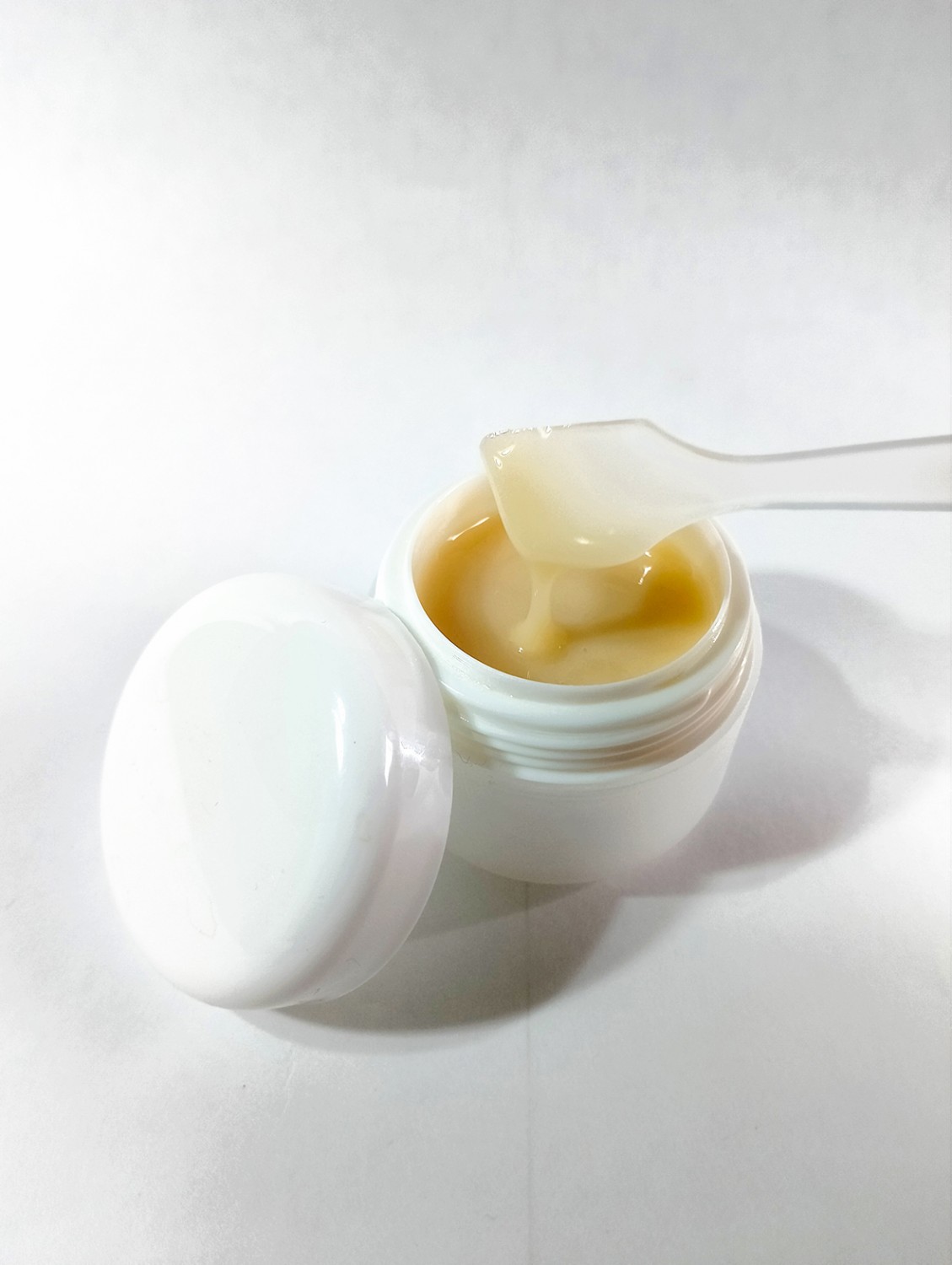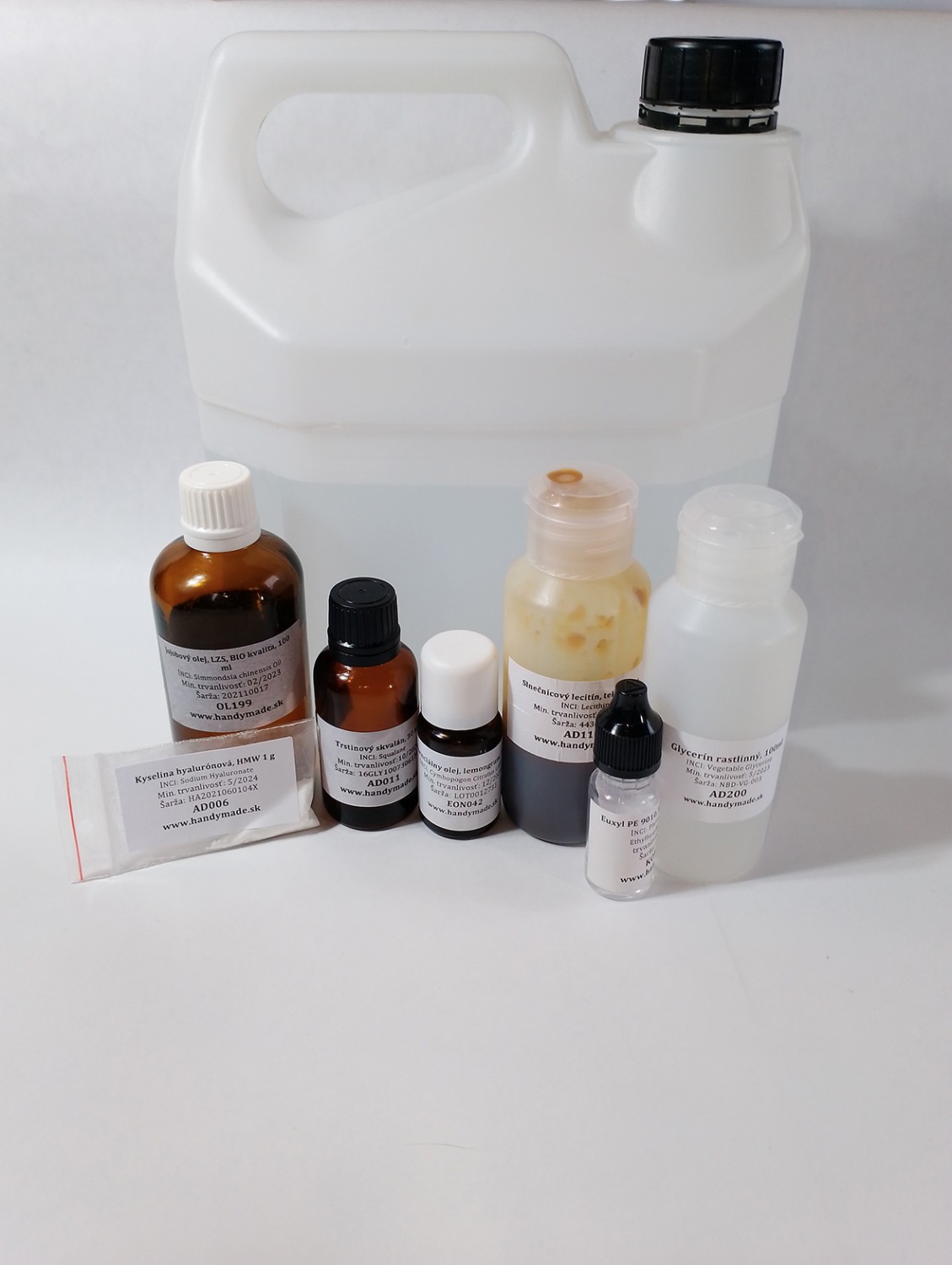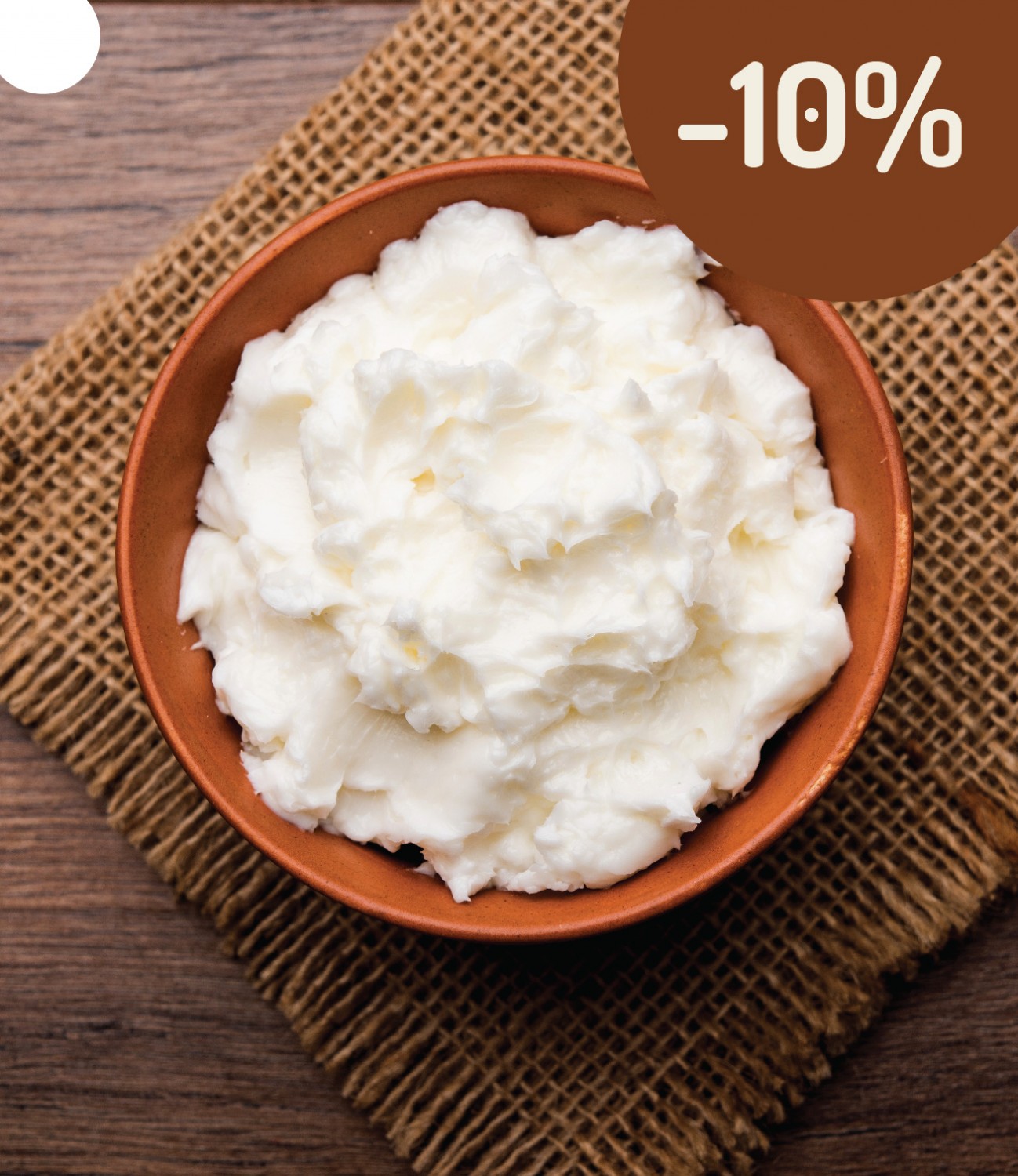Facial gel with hyaluronic acid
Skin gel with hyaluronic acid has a light texture, fast absorption and moisturizing effects. Make it with us.

If you are interested in a non-traditional form of facial gel that is not created using vegetable gums, try our hyaluronic acid gel. The moisturising formula of the facial gel without unnecessarily high oil content allows it to be absorbed quickly into the skin, thus providing the desired hydration.
Sunflower lecithin has been used to create the emulsion, which is a little more difficult to work with in recipes containing water, so this tutorial is particularly suitable for the more experienced.
FACIAL GEL WITH HYALURONIC ACID - INGREDIENTS
As mentioned, the light facial gel with hyaluronic acid contains water, but also a small amount of oils to nourish the skin. Also included is cane squalane, which is a great substitute for oils as it is quickly absorbed by the skin and does not form a greasy film on the skin.
INGREDIENCE PHASE%
A,B Demineralised water 81,89
A Hyaluronic acid HMW 1,00
A Glycerine 10,00
B Sunflower lecithin 3,00
C Cane squalane 1,00
C Jojoba oil 2,00
C Essential oil, lemongrass 0,10
D Euxyl PE 9010, preservative 1,00
plastic cup, milk

FACIAL GEL WITH HYALURONIC ACID - PROCEDURE
1. disinfect all utensils or containers and packaging that you will use or otherwise come into contact with the raw materials, e.g. with ethanol.
2. weigh demineralised water into one container. In another container, prepare a mixture of hyaluronic acid and glycerine, mix well until a thick slurry forms, let stand while you prepare the rest of the ingredients.
3.in a third container, weigh out the sunflower lecithin and add to it about a tenth of the volume of the demineralised water already weighed. Stir well, ideally with a milk frother or stick blender (for larger volumes), the sunflower lecithin needs time to hydrate (at least 30 minutes), otherwise it will not dissolve completely. Stir thoroughly every 30 minutes until the lecithin is completely dissolved.
4.in another container , weigh out the Phase C ingredients (jojoba and essential oils and cane squalane). Add these raw materials (phase C) to the thoroughly mixed sunflower lecithin solution, stirring constantly.
5. add the remaining water in small batches, stirring constantly, to the glycerol mixtureand hyaluronic acid until a thick gel is formed, which may contain lumps (see Tips and Tricks section for more information).
6.stirring constantly, add the gel to the mixture of lecithin and oils, stirring very thoroughly to combine all the ingredients.
7.then add the preservative and stir the mixture thoroughly again.
8.it is a good idea to let the mixture sit in a container covered with cling film overnight to give the hyaluronic acid enough time to thoroughly hydrate.
FACIAL GEL WITH HYALURONIC ACID - TIPS AND TRICKS
Using sunflower lecithin when making emulsions can be challenging at times, as it is not exactly the easiest emulsifier to work with. That's why it has been used in the production of a skin gel
with hyaluronic acid, the cold emulsion method was used, which makes the work a little easier and at the same time the sensitive raw materials are not exposed to elevated temperatures. Find out more about other tips and tricks on how to make hyaluronic acid facial gel.
Before combining the oil raw materials and the aqueous hyaluronic acid gel, it is necessary to thoroughly mix the sunflower lecithin in water. During the initial mixing, you will surely find that lumps of unmixed lecithin remain in the water. To reduce the amount of these lumps, it will help if you use a milk frother or stick blender to stir (for larger amounts of lecithin, use a milk frother or a stick blender to mix the lecithin).if you use a glass rod or spoon, most of the lecithin tends to stick to the spoon.
Once the lecithin has been hydrated (usually 30 minutes or longer is sufficient) and then stirred vigorously, you should no longer see bits of unstirred lecithin in the mixture.
At this point it is time to add the remaining ingredients.
Storage of the lotion gel is also important, avoid places with large fluctuations in temperature (small enclosed bathrooms, car during the summer, etc.). Also, direct intense sunlight can cause the emulsion to break down. It is a good idea to stir the mixture before each use, as lecithin gives a less stable emulsion.
If the emulsion keeps breaking down (water separating from the oils), the mixture has changed colour or smell, stop using the product, the gel is probably already spoiled. As lecithin contains a source of phosphorus for micro-organisms (normally the growth of micro-organisms in cosmetics is also limited by a lack of nutrients, which include phosphorus), even after use preservative, such a product will only last for a few weeks at most, so it is advisable to make smaller batches so that you always have fresh gel on hand.
FACIAL GEL WITH HYALURONIC ACID - INGREDIENTS AND THEIR IMPORTANCE
Below you will find a description of the different ingredients used to make the hyaluronic acid facial gel. You will also learn more about their function in the product, their possible substitutions or changes in dosage.
DEMINERALISED WATER
Since we are creating a classic water-based gel, we cannot do without the use of demineralised water in the recipe. This water is free of minerals that could undermine the stability of the product, which is particularlyparticularly important when you are creating emulsions, as in this case, because changing conditions can sometimes cause emulsions to break down. This is also why it is important to use demineralised or distilled water when making cosmetic products.
A possible substitute for demineralised water is floral hydrolates. These substances were also created by steam distillation, but different plants were used in the distillation process. Thus, different plant components are found in floral hydrolates, which give them their characteristic properties and a delicate floral scent.
In this case, you can replace part or all of the demineralised water with floral hydrolates. However, if the hydrolates have a very different pH from the water, you may find that this will affect the stability of the emulsion.
HYALURONIC ACID HMW
High molecular weight hyaluronic acid (HMW) is great for creating thick, water-based gelsthat not only apply well, but also provide effective hydration to the skin. When you try a product containing hyaluronic acid, you'll understand why this ingredient is a top ingredient for moisturizing and hydrating the skin.
HMW hyaluronic acid can also be replaced with a lower molecular weight alternative, LMW, which penetrates deeper into the skin due to its smaller particles. On the other hand, LMW hyaluronic acid does not have the ability to form as thick and firm gels as HMW hyaluronic acid, so if you are looking for a
you want a more gel-like consistency, but you also want the effects of LMW hyaluronic acid in your product, then combine the two types of hyaluronic acid.
GLYCERINE
One of the most common moisturizers for skin is glycerin. This colorless, syrupy substance dissolves well in water and allows powdered ingredients, in this case hyaluronic acid, to hydrate more quickly. Glycerine is not essential in the recipe, but its presence will reduce the formation of lumps and the resulting hyaluronic acid lumps will disappear more quickly.
You can also play around with the glycerin in the recipe if you want a more hydrating effect of the facial gel on the skin.
SUNFLOWER LECITHIN
The emulsifier in the hyaluronic acid gel recipe is sunflower lecithin. This substance is sometimes obtained as a by-product of oil refining and is made up of compounds that allow polar and non-polar substances, i.e. water and oils, to combine. Sunflower lecithin is a thick, dark brown substance similar in consistency to honey, which is slightly more difficult to mix in water. A substitute for sunflower lecithin may be soya lecithin with similar properties.
Also because of the dark colour of sunflower lecithin, the resulting product is beige in colour. If you do not like this colour, you can try to cover this colouring with, for example, mica powders. Add these powders to a mixture of glycerine and hyaluronic acid and mix well to form a thick slurry. This will ensure a more even dispersion of the mica powder in the product.
As mentioned, sunflower lecithin contains a phosphorus-containing phosphate group, which ensures that it binds to water; on the other hand, it is a source of this essential element for micro-organisms,
and so water-based products containing sunflower lecithin have a slightly shorter shelf life. When stored and preserved properly, they will last a few weeks at most, so it is better to produce smaller batches.
On the other hand, sunflower lecithin allows cold emulsions to form, which eliminates the need to expose vegetable oils to unnecessary heat, and the lecithin produces a silky-soft feel on the skin that you'll appreciate.
JOJOB OIL
Jojoba oil has also been used in the recipe for more effective hydration, which will be appreciated by combination or even dry skin. In this case, we reached for jojoba oil, which is well absorbed by the skin and does not leave a greasy film
and is a versatile oil for many cosmetic products.
However, jojoba oil is not the only oil you can use. Feel free to reach for any other vegetable oil you like. Alternatively, substitute this oil for cane squalane if you don't have it on hand. You can also increase the proportion of oil in the recipe, ideally by 1-2 %, otherwise the proportion of sunflower lecithin would also have to change.
If you omit both the oil and the cane squalane from the recipe, the need to use an emulsifier (sunflower lecithin) is lost and you only get a pure hyaluronic acid gel.
CANE SQUALANE
Cane squalane is an oily liquid sought after by the cosmetic industry because it absorbs into the skin even faster than conventional oils and effectively nourishes it without feeling greasy. Cane squalane can thus be substituted for oils in recipes.
In addition, cane squalane is very stable and adds elasticity to the skin, helping to replenish the loss of this substance in the skin, as the production of squalane decreases with age. Squalane is also very well suited as part of the foundation base under make-up.
ESSENTIAL OIL - LEMONGRASS
A subtle citrus scent is added to your products by lemongrass essential oil. The advantage of this oil is the fact that,
is that lemongrass is not citrus, although it does have a citrus scent. Because of this, it is not classified as a photosensitive oil, which could cause an allergic reaction on skin exposed to the sun. This is also why you can enjoy the products
with a citrus scent even during the summer.
Of course, lemongrass essential oil can be substituted with another essential oil, well it is allhowever, choose an essential oil that is not photosensitive, as it is a non-washable product. Or you can reach for fragrance oils that offer a wide variety of scents, including fruity ones.
Since sunflower lecithin has a distinctive scent that may not be pleasant to everyone, it's a good idea to choose at least a small amount of fragrance or essential oil to cover the smell of sunflower lecithin.
CONSERVANT
For the preservation of the product, the preservative Euxyl PE 9010 has been chosen, which is effective in both acidic and alkaline pH and is thus a good choice, especially for beginners. The preservative is particularly necessary in the lotion gel because,
because the product contains both water and sunflower lecithin, so do not underestimate the use of a preservative.
Of course, you can also reach for other broad-spectrum preservatives, but make sure to check if they will be effective at the pH of your product. If you are going to adjust the pH of your product, try it on smaller batches first, as a large change in pH can cause the emulsion to break down.
NOTICE
As mentioned, you can experiment with homemade recipes to achieve desired properties. However, many factors such as humidity, temperature, quality of ingredients or storage can affect the final result.
Before using any raw material to make a cosmetic product, familiarize yourself with its properties, recommended dosage, storage conditions or safe handling. Any raw material may have the potential to cause an allergic reaction in sensitive individuals, so before using a product, we recommend that you find out if you suffer from an allergy to any of the raw materials or the overall product, e.g. by a skin test.
If you have very sensitive or very acne-prone skin, or other skin and health problems, we recommend that you consult a medical professionalbefore applying a new product to your skin, whether it is a homemade cosmetic product, a pure raw material or a commercially available product.
HYALURONIC ACID FACIAL GEL - CONCLUSION
Facial gel with hyaluronic acid is a great helper especially during the hot summer. It adds hydration without putting unnecessary strain on the skin. Do you already have it at home?
If not, make it by following our blog tutorial. If you have any improvements, experiences or questions about making natural cosmetics, be sure to email us at marketing@handymade.sk
Thanks to Ivana Jačalová for the great post she prepared for us.
We look forward to hearing from you all.
In the meantime - keep up the good work, my friends.




